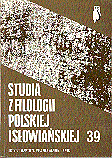Litewskie zaimki typu tas "ten" i ich polskie odpowiedniki
Lithuanian pronouns of tas ‘this’ type and their Polish counterparts
Author(s): Roman RoszkoSubject(s): Language and Literature Studies
Published by: Instytut Slawistyki Polskiej Akademii Nauk
Summary/Abstract: Lithuanian demonstrative pronouns create a structure that differs from the state known from the Polish language. Lithuanian pronouns šis, ši ‘this here’; šitas, šita ‘this here’ normally find their correspondents in Polish ten, ta ‘this here’. Lithuanian pronouns anas, ana ‘this there’ most often are projected onto Polish tamten, ów, owa ‘this there’. Defining Polish equivalents for Lithuanian tas, ta ‘this’, however, is more problematic. By default, Polish ten, ta ‘this’, which are formally identical with ten, ta ‘this here’, are used. But it is not always the case that Lithuanian tas, ta is fully represented by Polish ten, ta. Especially, when Lithuanian tas, ta is used as a part of a composite expression, e.g. tas vakaras, then an incompletely articulated lingual/quantificational expression is possible in Polish, e.g. wieczór. Some ways of Lithuanian tas use, identical with the use of neutral pronouns, like tai, tatai, šitai, šitatai, as well as to the use of masculine pronouns šitas, šis, correspond to the use of Polish to (neutr. sg) ‘this’, which differs from to ‘this here’. Unambiguity of Lithuanian tas, ta ‘this’ usage in relation to the polysemantic Polish ten: ‘this here’ and ‘this’ is conducive to the evolution leading to the development of the regular article.
Journal: Studia z Filologii Polskiej i Słowiańskiej
- Issue Year: 2004
- Issue No: 39
- Page Range: 89-98
- Page Count: 10
- Language: Polish

